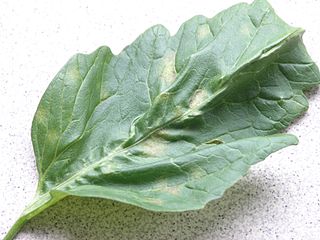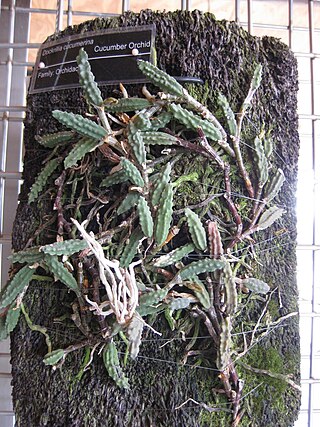
Cladosporium is a genus of fungi including some of the most common indoor and outdoor molds. Some species are endophytes or plant pathogens, while others parasitize fungi.
Davidiella tassiana is a fungal plant pathogen infecting several hosts, including Iris barnumiae subsp. demawendica in Iran.

Passalora fulva is a fungal plant pathogen that causes tomato leaf mold.

Radiotrophic fungi are fungi that can perform the hypothetical biological process called radiosynthesis, which means using ionizing radiation as an energy source to drive metabolism. It has been claimed that radiotrophic fungi have been found in extreme environments such as in the Chernobyl Nuclear Power Plant.
Cladosporium musae is a fungal plant pathogen that causes Cladosporium speckle on banana and which occurs in most countries in which the fruit is cultivated. Unsuccessful attempts to transfer the Cladosporium pathogen in vitro to healthy banana plants seem to confirm reports that the infection remains latent in otherwise healthy plants.

Calphostin C is a natural chemical compound. It is one of the calphostins, isolated from the fungus Cladosporium cladosporioides. Calphostin C is a potent inhibitor of protein kinase C (PKC).
The Davidiellaceae are a family of fungi in the Ascomycota, class Dothideomycetes. The family was defined in 2006 based on the results of molecular phylogenetic analysis of various Dothideomycetes species, and contains the genus Davidiella and six other genera.
Cladosporium dominicanum is a fungus found in hypersaline environments. It has globoid conidia. It has also been found in plant material.
Cladosporium psychrotolerans is a fungus found in hypersaline environments. It grows well at 4 °C but not at 30 °C, and has ornamented, globoid conidia with long digitate projections.
Cladosporium spinulosum is a fungus found in hypersaline environments. It has spherical, ornamented conidia with long digitate (finger-like) projections.
Cladosporium halotolerans is a fungus found in hypersaline environments. It has globoid conidia. It has also been isolated from bathrooms and in a dolphin.
Cladosporium fusiforme is a fungus found in hypersaline environments. It has ovoid to ellipsoid conidia. It has also been found in animal feed.
Rhodotorulapepsin is an enzyme. This enzyme catalyses the following chemical reaction
Cladosporium elegans is a species of fungus in the genus Cladosporium. It forms arid brown spots on living leaves of oranges in Italy.

Cladosporium cladosporioides is a darkly pigmented mold that occurs world-wide on a wide range of materials both outdoors and indoors. It is one of the most common fungi in outdoor air where its spores are important in seasonal allergic disease. While this species rarely causes invasive disease in animals, it is an important agent of plant disease, attacking both the leaves and fruits of many plants. This species produces asexual spores in delicate, branched chains that break apart readily and drift in the air. It is able to grow under low water conditions and at very low temperatures.

Dendrobium cucumerinum, commonly known as the cucumber orchid or gherkin orchid, is a species of orchid endemic to eastern Australia. It is an epiphytic orchid with creeping stems, gherkin-like leaves and flowering stems with up to eighteen cream-coloured, yellowish or greenish white flowers with purple stripes. It often grows on large trees near streams but is also found in drier forests.

Cladosporium sphaerospermum is a radiotrophic fungus belonging to the genus Cladosporium and was described in 1886 by Albert Julius Otto Penzig from the decaying leaves and branches of Citrus. It is a dematiaceous (darkly-pigmented) fungus characterized by slow growth and largely asexual reproduction. Cladosporium sphaerospermum consists of a complex of poorly morphologically differentiated, "cryptic" species that share many physiological and ecological attributes. In older literature, all of these sibling species were classified as C. sphaerospermum despite their unique nature. Accordingly, there is confusion in older literature reports on the physiological and habitat regularities of C. sphaerospermum in the strict sense. This fungus is most phylogenetically similar to C. fusiforme. According to modern phylogenetic analyses, the previously synonymized species, Cladosporium langeroni, is a distinct species.
Cladosporium oxysporum is an airborne fungus that is commonly found outdoors and is distributed throughout the tropical and subtropical region, it is mostly located In Asia and Africa. It spreads through airborne spores and is often extremely abundant in outdoor air during the spring and summer seasons. It mainly feeds on decomposing organic matter in warmer climates, but can also be parasitic and feed on living plants. The airborne spores can occasionally cause cutaneous infections in humans, and the high prevalence of C. oxysporum in outdoor air during warm seasons contributes to its importance as an etiological agent of allergic disease and possibly human cutaneous phaeohyphomycosis in tropical regions.
Cladosporium herbarum is a common fungus found worldwide in organic and inorganic matter. It is efficiently distributed in the air, where it exists as the most frequently occurring fungal species. It can grow over a wide range of temperatures including very cold environments, giving it the ability to grow on refrigerated meat and form "black spots". Its high prevalence in the air and production of allergens makes C. herbarum an important exacerbant of asthma and hay fever.







